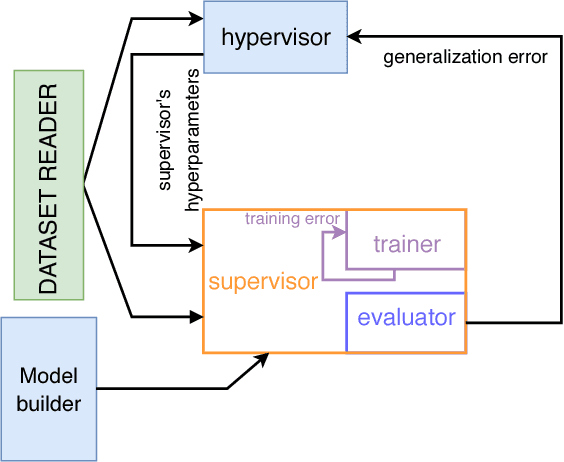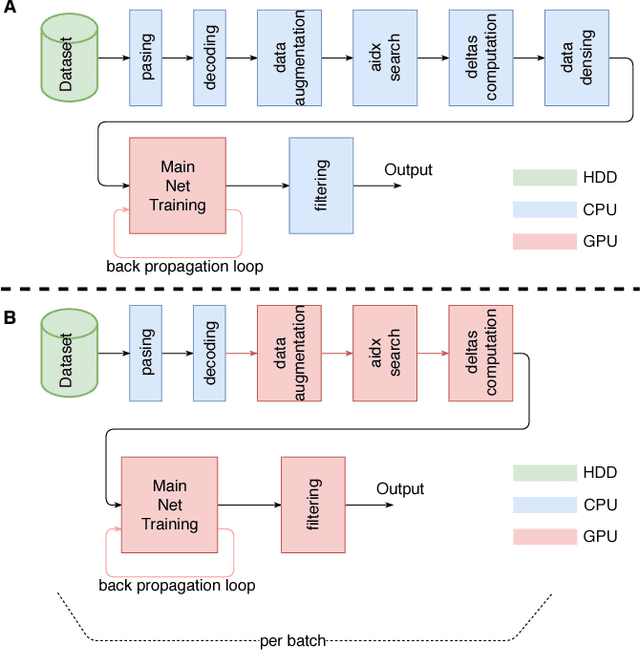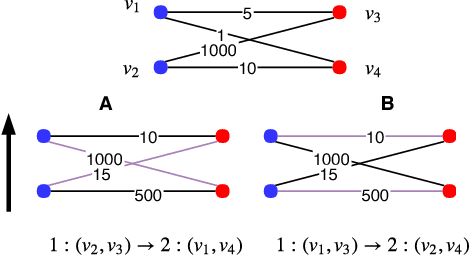Ioannis Athanasiadis
Model Stitching by Functional Latent Alignment
May 26, 2025Abstract:Evaluating functional similarity involves quantifying the degree to which independently trained neural networks learn functionally similar representations. Reliably inferring the functional similarity of these networks remains an open problem with far-reaching implications for AI. Model stitching has emerged as a promising paradigm, where an optimal affine transformation aligns two models to solve a task, with the stitched model serving as a proxy for functional similarity. In this work, we draw inspiration from the knowledge distillation literature and propose Functional Latent Alignment (FuLA) as a novel optimality condition for model stitching. We revisit previously explored functional similarity testbeds and introduce a new one, based on which FuLA emerges as an overall more reliable method of functional similarity. Specifically, our experiments in (a) adversarial training, (b) shortcut training and, (c) cross-layer stitching, reveal that FuLA is less prone to artifacts tied to training on task cues while achieving non-trivial alignments that are missed by stitch-level matching.
Interactive Double Deep Q-network: Integrating Human Interventions and Evaluative Predictions in Reinforcement Learning of Autonomous Driving
Apr 28, 2025Abstract:Integrating human expertise with machine learning is crucial for applications demanding high accuracy and safety, such as autonomous driving. This study introduces Interactive Double Deep Q-network (iDDQN), a Human-in-the-Loop (HITL) approach that enhances Reinforcement Learning (RL) by merging human insights directly into the RL training process, improving model performance. Our proposed iDDQN method modifies the Q-value update equation to integrate human and agent actions, establishing a collaborative approach for policy development. Additionally, we present an offline evaluative framework that simulates the agent's trajectory as if no human intervention had occurred, to assess the effectiveness of human interventions. Empirical results in simulated autonomous driving scenarios demonstrate that iDDQN outperforms established approaches, including Behavioral Cloning (BC), HG-DAgger, Deep Q-Learning from Demonstrations (DQfD), and vanilla DRL in leveraging human expertise for improving performance and adaptability.
Hybrid Phenology Modeling for Predicting Temperature Effects on Tree Dormancy
Jan 28, 2025Abstract:Biophysical models offer valuable insights into climate-phenology relationships in both natural and agricultural settings. However, there are substantial structural discrepancies across models which require site-specific recalibration, often yielding inconsistent predictions under similar climate scenarios. Machine learning methods offer data-driven solutions, but often lack interpretability and alignment with existing knowledge. We present a phenology model describing dormancy in fruit trees, integrating conventional biophysical models with a neural network to address their structural disparities. We evaluate our hybrid model in an extensive case study predicting cherry tree phenology in Japan, South Korea and Switzerland. Our approach consistently outperforms both traditional biophysical and machine learning models in predicting blooming dates across years. Additionally, the neural network's adaptability facilitates parameter learning for specific tree varieties, enabling robust generalization to new sites without site-specific recalibration. This hybrid model leverages both biophysical constraints and data-driven flexibility, offering a promising avenue for accurate and interpretable phenology modeling.
Prior Learning in Introspective VAEs
Aug 25, 2024Abstract:Variational Autoencoders (VAEs) are a popular framework for unsupervised learning and data generation. A plethora of methods have been proposed focusing on improving VAEs, with the incorporation of adversarial objectives and the integration of prior learning mechanisms being prominent directions. When it comes to the former, an indicative instance is the recently introduced family of Introspective VAEs aiming at ensuring that a low likelihood is assigned to unrealistic samples. In this study, we focus on the Soft-IntroVAE (S-IntroVAE) and investigate the implication of incorporating a multimodal and learnable prior into this framework. Namely, we formulate the prior as a third player and show that when trained in cooperation with the decoder constitutes an effective way for prior learning, which shares the Nash Equilibrium with the vanilla S-IntroVAE. Furthermore, based on a modified formulation of the optimal ELBO in S-IntroVAE, we develop theoretically motivated regularizations, that is (i) adaptive variance clipping to stabilize training when learning the prior and (ii) responsibility regularization to discourage the formation of inactive prior mode. Finally, we perform a series of targeted experiments on a 2D density estimation benchmark and in an image generation setting comprised of the (F)-MNIST and CIFAR-10 datasets demonstrating the benefit of prior learning in S-IntroVAE in generation and representation learning.
Causal machine learning for sustainable agroecosystems
Aug 23, 2024

Abstract:In a changing climate, sustainable agriculture is essential for food security and environmental health. However, it is challenging to understand the complex interactions among its biophysical, social, and economic components. Predictive machine learning (ML), with its capacity to learn from data, is leveraged in sustainable agriculture for applications like yield prediction and weather forecasting. Nevertheless, it cannot explain causal mechanisms and remains descriptive rather than prescriptive. To address this gap, we propose causal ML, which merges ML's data processing with causality's ability to reason about change. This facilitates quantifying intervention impacts for evidence-based decision-making and enhances predictive model robustness. We showcase causal ML through eight diverse applications that benefit stakeholders across the agri-food chain, including farmers, policymakers, and researchers.
Causality and Explainability for Trustworthy Integrated Pest Management
Dec 07, 2023



Abstract:Pesticides serve as a common tool in agricultural pest control but significantly contribute to the climate crisis. To combat this, Integrated Pest Management (IPM) stands as a climate-smart alternative. Despite its potential, IPM faces low adoption rates due to farmers' skepticism about its effectiveness. To address this challenge, we introduce an advanced data analysis framework tailored to enhance IPM adoption. Our framework provides i) robust pest population predictions across diverse environments with invariant and causal learning, ii) interpretable pest presence predictions using transparent models, iii) actionable advice through counterfactual explanations for in-season IPM interventions, iv) field-specific treatment effect estimations, and v) assessments of the effectiveness of our advice using causal inference. By incorporating these features, our framework aims to alleviate skepticism and encourage wider adoption of IPM practices among farmers.
Evaluating Digital Agriculture Recommendations with Causal Inference
Nov 30, 2022



Abstract:In contrast to the rapid digitalization of several industries, agriculture suffers from low adoption of smart farming tools. While AI-driven digital agriculture tools can offer high-performing predictive functionalities, they lack tangible quantitative evidence on their benefits to the farmers. Field experiments can derive such evidence, but are often costly, time consuming and hence limited in scope and scale of application. To this end, we propose an observational causal inference framework for the empirical evaluation of the impact of digital tools on target farm performance indicators (e.g., yield in this case). This way, we can increase farmers' trust via enhancing the transparency of the digital agriculture market and accelerate the adoption of technologies that aim to secure farmer income resilience and global agricultural sustainability. As a case study, we designed and implemented a recommendation system for the optimal sowing time of cotton based on numerical weather predictions, which was used by a farmers' cooperative during the growing season of 2021. We then leverage agricultural knowledge, collected yield data, and environmental information to develop a causal graph of the farm system. Using the back-door criterion, we identify the impact of sowing recommendations on the yield and subsequently estimate it using linear regression, matching, inverse propensity score weighting and meta-learners. The results reveal that a field sown according to our recommendations exhibited a statistically significant yield increase that ranged from 12% to 17%, depending on the method. The effect estimates were robust, as indicated by the agreement among the estimation methods and four successful refutation tests. We argue that this approach can be implemented for decision support systems of other fields, extending their evaluation beyond a performance assessment of internal functionalities.
Evaluating Digital Tools for Sustainable Agriculture using Causal Inference
Nov 06, 2022



Abstract:In contrast to the rapid digitalization of several industries, agriculture suffers from low adoption of climate-smart farming tools. Even though AI-driven digital agriculture can offer high-performing predictive functionalities, it lacks tangible quantitative evidence on its benefits to the farmers. Field experiments can derive such evidence, but are often costly and time consuming. To this end, we propose an observational causal inference framework for the empirical evaluation of the impact of digital tools on target farm performance indicators. This way, we can increase farmers' trust by enhancing the transparency of the digital agriculture market, and in turn accelerate the adoption of technologies that aim to increase productivity and secure a sustainable and resilient agriculture against a changing climate. As a case study, we perform an empirical evaluation of a recommendation system for optimal cotton sowing, which was used by a farmers' cooperative during the growing season of 2021. We leverage agricultural knowledge to develop a causal graph of the farm system, we use the back-door criterion to identify the impact of recommendations on the yield and subsequently estimate it using several methods on observational data. The results show that a field sown according to our recommendations enjoyed a significant increase in yield (12% to 17%).
A Framework of Transfer Learning in Object Detection for Embedded Systems
Nov 24, 2018



Abstract:Transfer learning is one of the subjects undergoing intense study in the area of machine learning. In object recognition and object detection there are known experiments for the transferability of parameters, but not for neural networks which are suitable for object detection in real time embedded applications, such as the SqueezeDet neural network. We use transfer learning to accelerate the training of SqueezeDet to a new group of classes. Also, experiments are conducted to study the transferability and co-adaptation phenomena introduced by the transfer learning process. To accelerate training, we propose a new implementation of the SqueezeDet training which provides a faster pipeline for data processing and achieves 1.8 times speedup compared to the initial implementation. Finally, we created a mechanism for automatic hyperparameter optimization using an empirical method.
 Add to Chrome
Add to Chrome Add to Firefox
Add to Firefox Add to Edge
Add to Edge